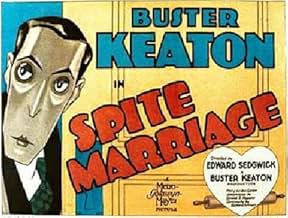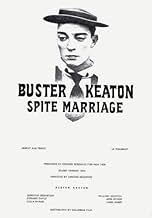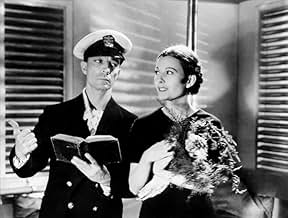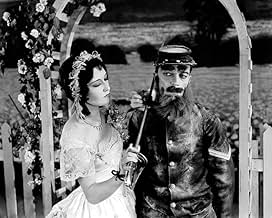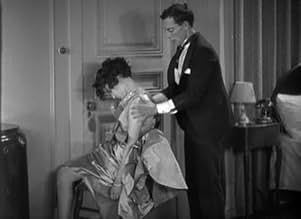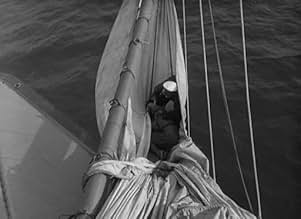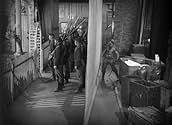Añade un argumento en tu idiomaAn unimpressive but well intending man is given the chance to marry a popular actress, of whom he has been a hopeless fan. But what he doesn't realize is that he is being used to make the ac... Leer todoAn unimpressive but well intending man is given the chance to marry a popular actress, of whom he has been a hopeless fan. But what he doesn't realize is that he is being used to make the actress' old flame jealous.An unimpressive but well intending man is given the chance to marry a popular actress, of whom he has been a hopeless fan. But what he doesn't realize is that he is being used to make the actress' old flame jealous.
- Dirección
- Guión
- Reparto principal
- Giovanni Scarzi
- (as John Byron)
- Rumrunner
- (sin acreditar)
- The Bellboy
- (sin acreditar)
- Man in Ship's Engine Room
- (sin acreditar)
- Tugboat Captain
- (sin acreditar)
- Man in Audience Next to Elmer
- (sin acreditar)
- Actor as 'Union Officer'
- (sin acreditar)
- Stage Manager
- (sin acreditar)
- Tough Sailor
- (sin acreditar)
Reseñas destacadas
Elmer Gantry (Keaton) runs a laundry, which allows him plenty of time and access to fine clothes for stalking in the guise of a rich suitor stage star Trilby Drew (Dorothy Sebastian). Trilby attaches herself to fellow star player Lionel Benmore (Edward Earle), but when Benmore takes up with a society beauty, Trilby decides to marry Elmer to show him up, to her later regret.
"Spite Marriage" is Keaton's last silent comedy (except for a short called "The Railrodder" he made near the end of his career). It's better than several of the features he made before being picked up by MGM the year before, specifically "College," "Go West," "Three Ages," and "The Saphead." But it falls short of classic Buster, often because of the role played by Buster himself.
For almost all of the first 30 minutes, viewers have to adjust to the novel notion of Buster the idiot. After an abrupt opening, we see Buster fumbling around on horseback, wiggling lovelorn in his seat as Trilby performs on stage, and finally sneaking on stage to make a mess of the show. It is funny, but in a frustrating, jerky way.
Too often the film calls attention to Buster's fish-out-of-water character, particularly when he joins the cast and stumbles over assorted props, to the annoying amusement of the audience. In his earlier films, Buster was a stoic victim of mayhem, rather than producing it himself. This made the comedy work without lessening the character. Here, you can't help but emphasize with the theatrical agent who moans: "Shoot him! They'll think it's part of the act!"
There are also odd bits of sympathy trolling. We see him bring her a stuffed dog doll with a tear running down one eye. After he discovers Trilby has left him, the camera lingers on the doll one last time, as an overt nod to Elmer's pitiful state. It's like something out of Harry Langdon.
But there are compensations throughout the early part. Trilby's play, "Carolina," is a wonderful send-up of theatrical conventions. When Lionel makes his entrance as a wounded fugitive, he stops to acknowledge the applause. "A scratch is nothing to a Southern gentleman," he tells Trilby's character, a goofy line that gets a nifty callback late in the film.
Sebastian is a big part of why "Spite Marriage" works as well as it does. For the first time, I watched a Keaton feature not pining for Sybil Seely. Trilby is no gentle flower, but rather a scheming, petty character who uses Elmer's affection for her own ends. As an ex-spite boyfriend, I could relate to this. Most important, she is very funny, especially in a scene in a speakeasy where she gets drunk and loses her cool when she sees Lionel with his new babe. It's a great use of Buster's expressionless manner by director Edward Sedgwick and the MGM team, playing it off Sebastian's scowling and histrionics. She also takes a fall as well as Buster, which helps.
The movie's most famous scene uses her athleticism to splendid effect, where he tries to put his unconscious bride to bed. He tries to sit her on a chair, only to have her roll off. As other reviewers here note, it's easy to ignore the effort she must put forth, keeping Buster hopping without apparently moving a muscle.
The finale, aboard a yacht, is the film's best sequence. Ironically, as historians John Bengtson and Jeffrey Vance note in their helpful DVD commentary, this was one part of the movie Buster didn't want to do, probably concerned he was repeating "The Navigator." But "Spite Marriage" takes the same idea in different directions, and most importantly, ramps up the laughter while giving us Buster in take-charge form. A key bit of business involves his wearing a captain's hat, which seems to signal a sense of newfound authority for the performer.
Alas, it was not to be. Buster's subsequent work for MGM, while quite profitable, would run the gamut from weak to awful, with Buster himself anything but in charge. "Spite Marriage," with its misplaced emphasis on poor, stupid Elmer, would inaugurate this trend, but it's more of a piece with his days as silent comedy's master clown. Keep this in mind, and you will have a good time.
In this one, he plays a hapless Romeo, devoted to stage actress Dorothy Sebastian. He sees her every performance and brings her bouquets of roses. The only trouble is Dorothy's in love with her costar; but when he marries someone else, she gets even by marrying Buster out of spite. The story jumps around quite a bit, so you might think you're seeing three movies in one. The first part of the film takes place in the theater, in the second part, Buster falls in with a crowd of gangsters, and in the final third, Buster and Dorothy are the only survivors on a sinking ship. While it might seem random, you won't have time to question it because you'll be mesmerized by Buster's incredible stunt work. He hangs from a rope on the mast, repeatedly gets thrown overboard only to catch himself on the boom and leap back on deck, and even falls into the sail and has to pull himself back up. Dorothy is a real trouper, participating in many of his stunts and gags, including the famous bedroom skit, recreated later by Buster and his wife onstage and by Donald O'Connor and Ann Blythe in The Buster Keaton Story. This movie feels like a very fond farewell to Buster Keaton's silent pictures, with all the elements of his famous films thrown together: a lovesick hero, dangerous stunts, funny gags, and a ship. Really the only thing missing is a train, but you can find one in almost every other of his movies.
The premise of the "Spite Marriage" is rather flimsy at best, and in other hands it probably would not have been even this good. It actually starts out pretty well, as the first part moves at a good pace, and includes a very good sequence with Buster's hapless character trying to take part in a play. It begins to peter out in the middle, though, as the premise begins to wear thin. For some reason, the bedroom sequence from this portion seems to be the best-remembered portion of the movie, but it really isn't one of the better parts of the film at all. But things pick up again in the last part, when the story takes a couple of unexpected turns, and the comedy also improves.
To be sure, it is a shame that Keaton was forced into the studio mold in pictures like this. It worked for many, but not for a unique talent like Buster. Still, at least this time the result is a generally entertaining movie with more than enough laughs to make it worth watching for anyone who enjoys silent comedies.
With all of that said, 'Spite Marriage' has a 34-year-old Buster Keaton still in his prime, and some pretty clever scenes. He gets enlisted into a stage play in the first part, and after botching up his make-up while another actor puts his on professionally, proceeds to foul up the production in various funny ways. As he tries to elude those chasing him afterwards, he does a rapid change into a top hat and tails that is both entertaining and shows off his muscular body. Later in the film, he does some impressive stuntwork on a yacht, at one point getting thrown off, and then as the yacht goes by quickly, catches a small boat trailing behind and hauls himself into it. Throughout the movie, he's lovable and a joy to watch. This was Keaton's last silent picture, and as the 1930's would not be kind to him, it marks a transition for him. If you can avoid comparing it to his masterpieces (which I know is tough!), you'll probably find it's well worth watching.
¿Sabías que...?
- CuriosidadesBuster Keaton wanted this film to be a full talkie, but MGM released it with only a musical score and sound effects. One thing that prevented this picture from being a full talkie was that MGM was late to the sound game and had only one full set of recording equipment at the time. Its Loew's Theater chain also was not yet fully equipped to show sound pictures. Plus, MGM's head of production reasoned Keaton's films were made with a lot of time-consuming improvisations and didn't think the added expense of using valuable, scarce sound equipment was worth it.
- PifiasIn the dressing-room, while attempting to trim the hair for his false beard, Elmer accidentally severs the left-hand shoulder strap of his tank-top undershirt and has no time to repair it. When he hurriedly changes back into his smart clothes after the performance, both straps are still whole.
- Citas
Trilby Drew: What's that blonde hanging around you for?
Lionel Benmore: Can I help it if I'm good-looking?
- Créditos adicionalesRather than appear at the beginning, the MGM roaring lion opening appears after the conclusion of the film, but just before "The End" title, which immediately follows it.
- ConexionesFeatured in Arena: Cinema: Christmas Special (1976)
- Banda sonoraI'd Rather Be Blue Over You
(uncredited)
Music by Fred Fisher
Lyrics by Billy Rose
Played as background music at the cafe
Selecciones populares
- How long is Spite Marriage?Con tecnología de Alexa
Detalles
- Fecha de lanzamiento
- País de origen
- Idiomas
- Títulos en diferentes países
- Spite Marriage
- Localizaciones del rodaje
- Hotel Carmel - 201 Broadway St, Santa Mónica, California, Estados Unidos(Lionel confronts Buster outside this hotel on the 2nd Street side - still in business in 2022)
- Empresa productora
- Ver más compañías en los créditos en IMDbPro
- Duración
- 1h 16min(76 min)
- Relación de aspecto
- 1.33 : 1

